Report: Implementation of IoT in Healthcare Industry of Australia
VerifiedAdded on 2023/01/18
|6
|915
|86
Report
AI Summary
This report investigates the implementation of the Internet of Things (IoT) in the healthcare industry of Australia. It begins by outlining the problem statement, which highlights the challenges of providing timely healthcare services and the potential of IoT solutions like smart devices to address these issues. The research aims to analyze the issues faced by the healthcare industry without IoT, evaluate the impact of IoT, and recommend strategies for improved use. The methodology employs a qualitative approach, using secondary data from journals and databases, analyzed through thematic analysis. The report includes a timeline for the research and anticipates positive outcomes, such as minimizing issues in healthcare. The references section provides a list of academic sources used in the study.
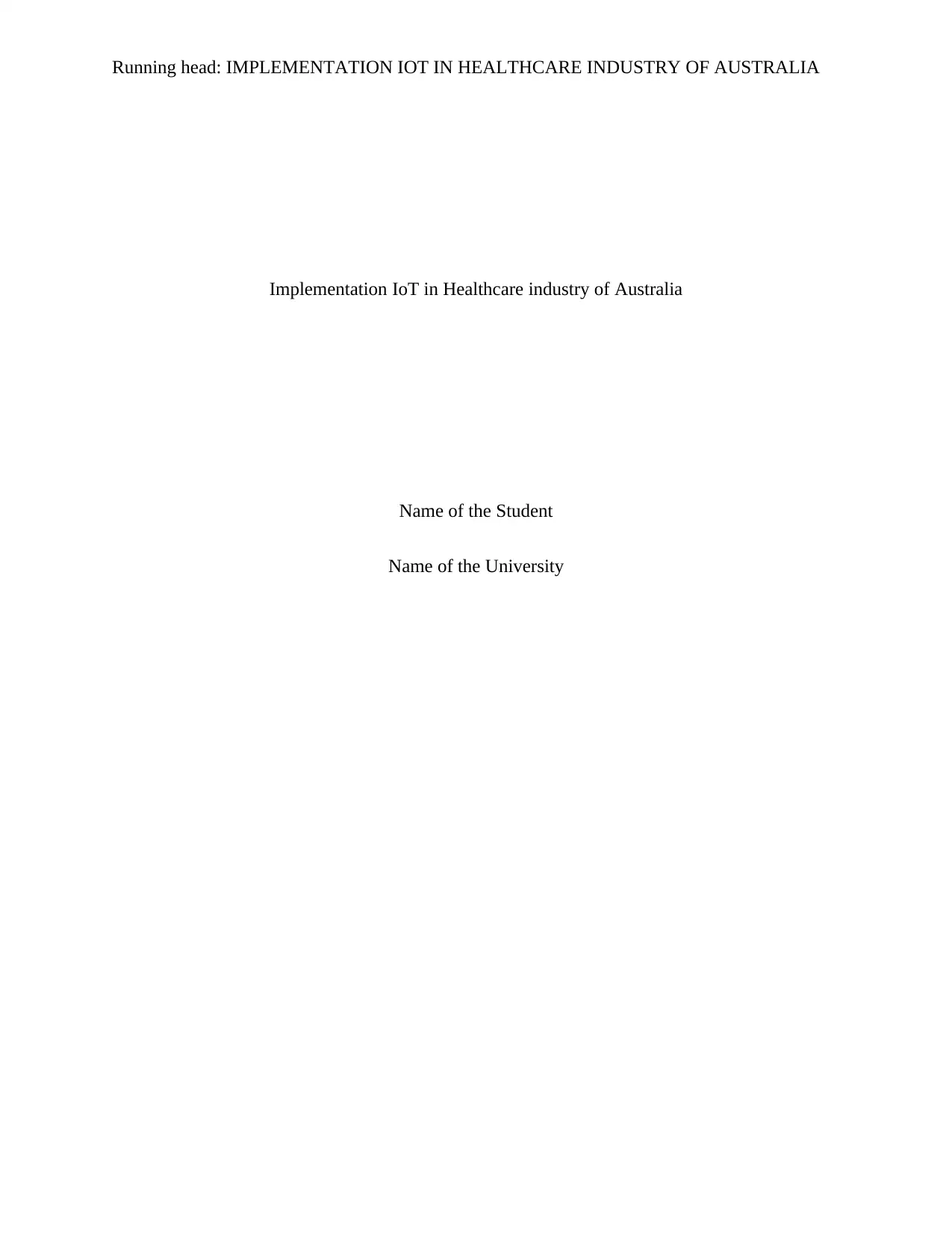
Running head: IMPLEMENTATION IOT IN HEALTHCARE INDUSTRY OF AUSTRALIA
Implementation IoT in Healthcare industry of Australia
Name of the Student
Name of the University
Implementation IoT in Healthcare industry of Australia
Name of the Student
Name of the University
Paraphrase This Document
Need a fresh take? Get an instant paraphrase of this document with our AI Paraphraser
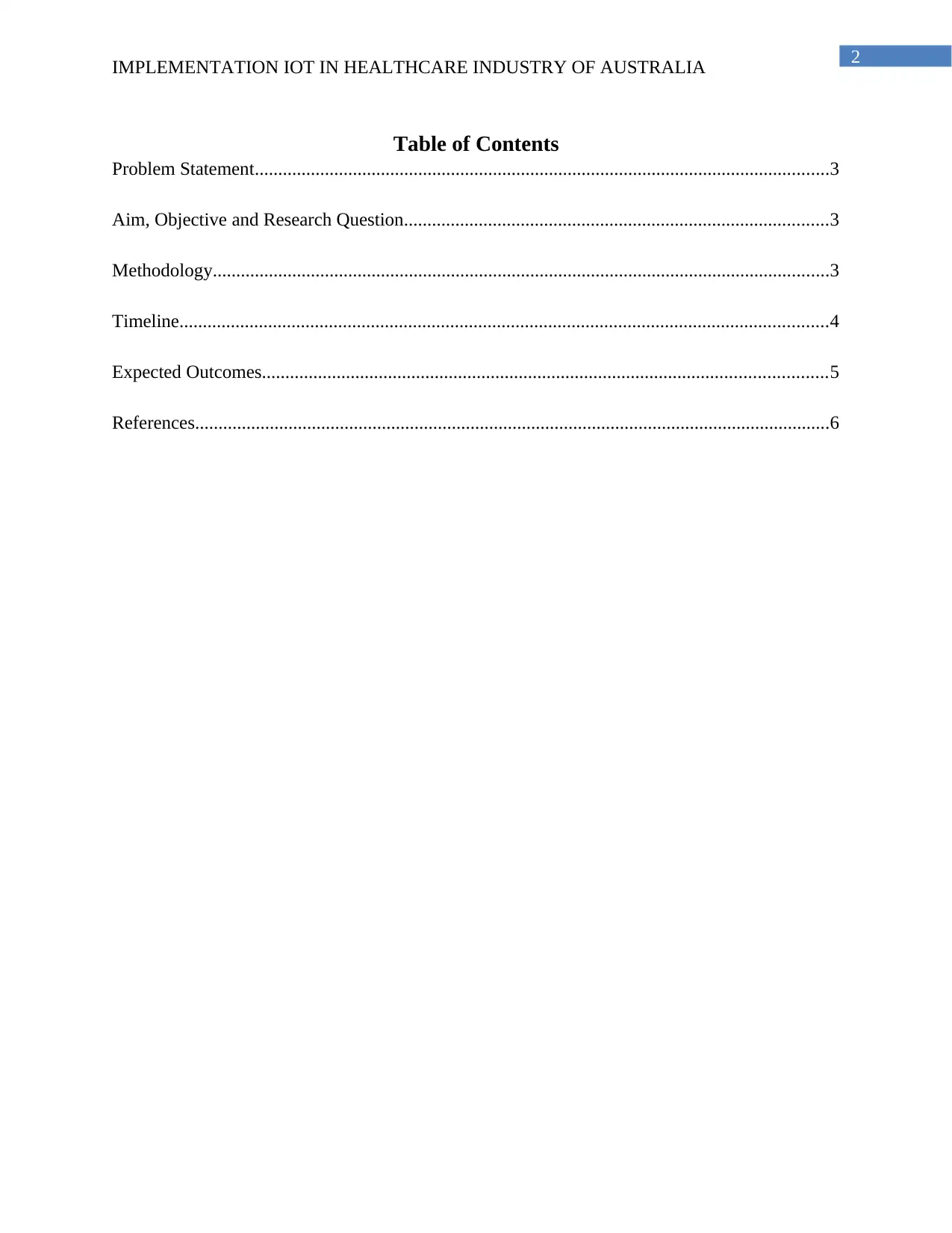
2
IMPLEMENTATION IOT IN HEALTHCARE INDUSTRY OF AUSTRALIA
Table of Contents
Problem Statement...........................................................................................................................3
Aim, Objective and Research Question...........................................................................................3
Methodology....................................................................................................................................3
Timeline...........................................................................................................................................4
Expected Outcomes.........................................................................................................................5
References........................................................................................................................................6
IMPLEMENTATION IOT IN HEALTHCARE INDUSTRY OF AUSTRALIA
Table of Contents
Problem Statement...........................................................................................................................3
Aim, Objective and Research Question...........................................................................................3
Methodology....................................................................................................................................3
Timeline...........................................................................................................................................4
Expected Outcomes.........................................................................................................................5
References........................................................................................................................................6
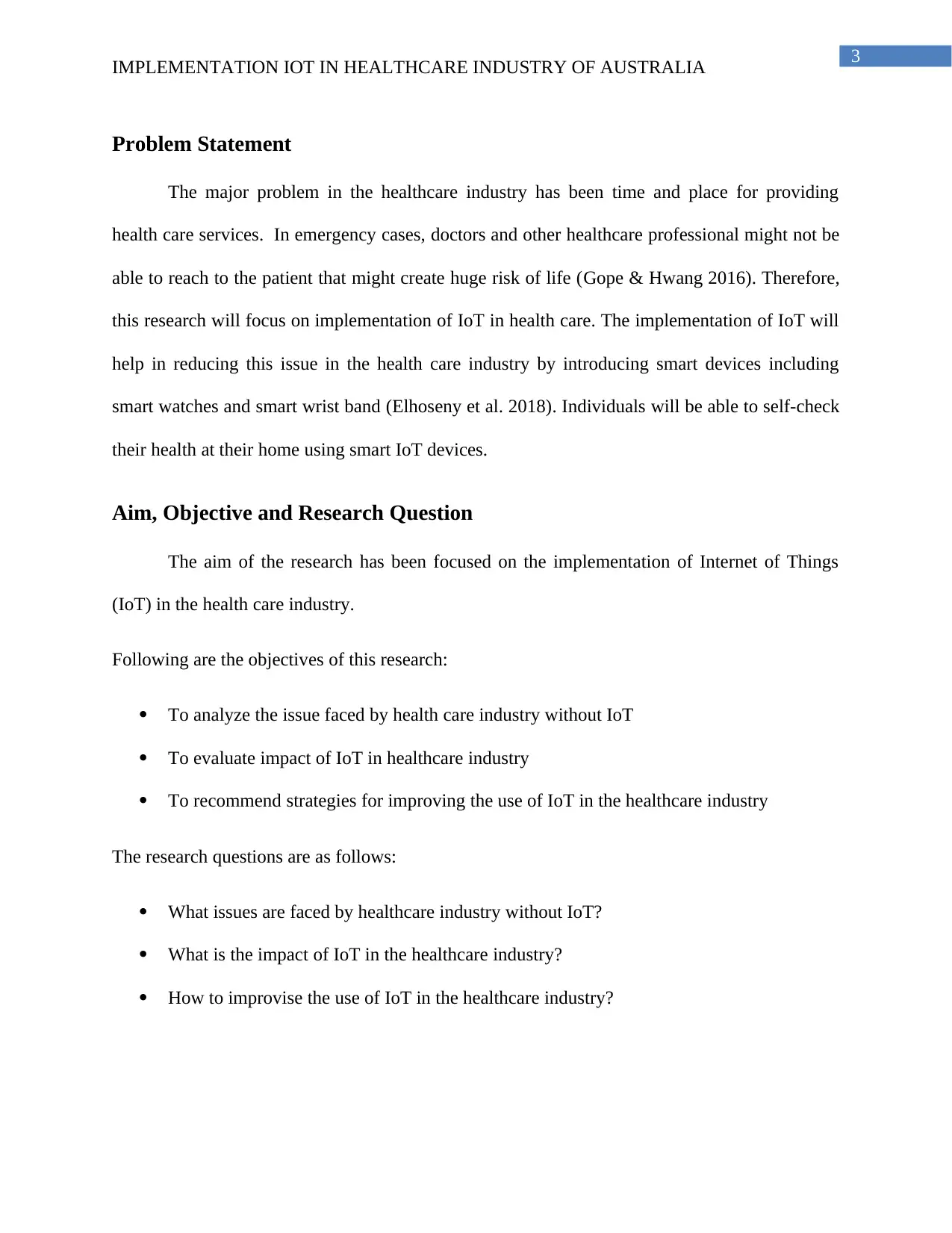
3
IMPLEMENTATION IOT IN HEALTHCARE INDUSTRY OF AUSTRALIA
Problem Statement
The major problem in the healthcare industry has been time and place for providing
health care services. In emergency cases, doctors and other healthcare professional might not be
able to reach to the patient that might create huge risk of life (Gope & Hwang 2016). Therefore,
this research will focus on implementation of IoT in health care. The implementation of IoT will
help in reducing this issue in the health care industry by introducing smart devices including
smart watches and smart wrist band (Elhoseny et al. 2018). Individuals will be able to self-check
their health at their home using smart IoT devices.
Aim, Objective and Research Question
The aim of the research has been focused on the implementation of Internet of Things
(IoT) in the health care industry.
Following are the objectives of this research:
To analyze the issue faced by health care industry without IoT
To evaluate impact of IoT in healthcare industry
To recommend strategies for improving the use of IoT in the healthcare industry
The research questions are as follows:
What issues are faced by healthcare industry without IoT?
What is the impact of IoT in the healthcare industry?
How to improvise the use of IoT in the healthcare industry?
IMPLEMENTATION IOT IN HEALTHCARE INDUSTRY OF AUSTRALIA
Problem Statement
The major problem in the healthcare industry has been time and place for providing
health care services. In emergency cases, doctors and other healthcare professional might not be
able to reach to the patient that might create huge risk of life (Gope & Hwang 2016). Therefore,
this research will focus on implementation of IoT in health care. The implementation of IoT will
help in reducing this issue in the health care industry by introducing smart devices including
smart watches and smart wrist band (Elhoseny et al. 2018). Individuals will be able to self-check
their health at their home using smart IoT devices.
Aim, Objective and Research Question
The aim of the research has been focused on the implementation of Internet of Things
(IoT) in the health care industry.
Following are the objectives of this research:
To analyze the issue faced by health care industry without IoT
To evaluate impact of IoT in healthcare industry
To recommend strategies for improving the use of IoT in the healthcare industry
The research questions are as follows:
What issues are faced by healthcare industry without IoT?
What is the impact of IoT in the healthcare industry?
How to improvise the use of IoT in the healthcare industry?
⊘ This is a preview!⊘
Do you want full access?
Subscribe today to unlock all pages.

Trusted by 1+ million students worldwide
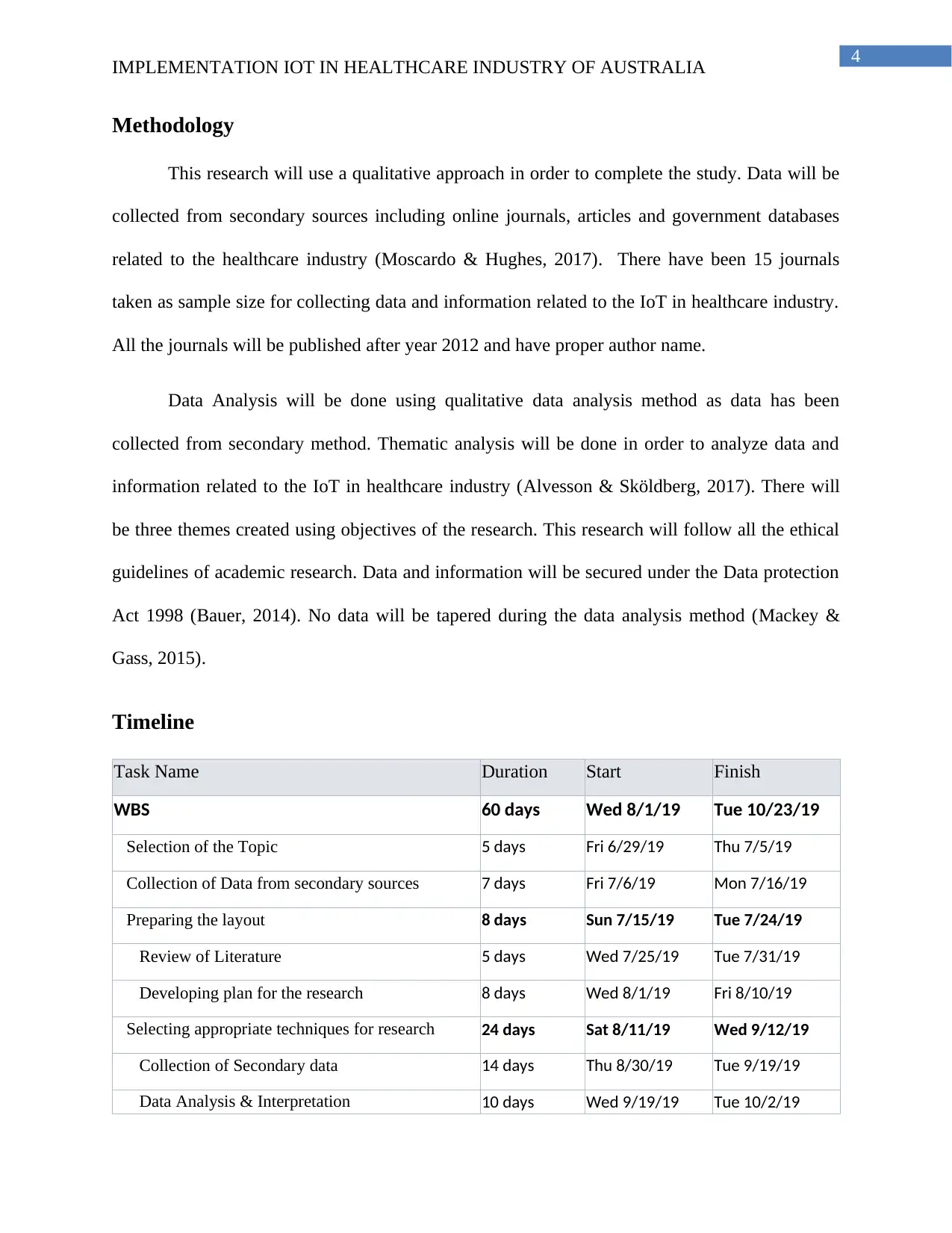
4
IMPLEMENTATION IOT IN HEALTHCARE INDUSTRY OF AUSTRALIA
Methodology
This research will use a qualitative approach in order to complete the study. Data will be
collected from secondary sources including online journals, articles and government databases
related to the healthcare industry (Moscardo & Hughes, 2017). There have been 15 journals
taken as sample size for collecting data and information related to the IoT in healthcare industry.
All the journals will be published after year 2012 and have proper author name.
Data Analysis will be done using qualitative data analysis method as data has been
collected from secondary method. Thematic analysis will be done in order to analyze data and
information related to the IoT in healthcare industry (Alvesson & Sköldberg, 2017). There will
be three themes created using objectives of the research. This research will follow all the ethical
guidelines of academic research. Data and information will be secured under the Data protection
Act 1998 (Bauer, 2014). No data will be tapered during the data analysis method (Mackey &
Gass, 2015).
Timeline
Task Name Duration Start Finish
WBS 60 days Wed 8/1/19 Tue 10/23/19
Selection of the Topic 5 days Fri 6/29/19 Thu 7/5/19
Collection of Data from secondary sources 7 days Fri 7/6/19 Mon 7/16/19
Preparing the layout 8 days Sun 7/15/19 Tue 7/24/19
Review of Literature 5 days Wed 7/25/19 Tue 7/31/19
Developing plan for the research 8 days Wed 8/1/19 Fri 8/10/19
Selecting appropriate techniques for research 24 days Sat 8/11/19 Wed 9/12/19
Collection of Secondary data 14 days Thu 8/30/19 Tue 9/19/19
Data Analysis & Interpretation 10 days Wed 9/19/19 Tue 10/2/19
IMPLEMENTATION IOT IN HEALTHCARE INDUSTRY OF AUSTRALIA
Methodology
This research will use a qualitative approach in order to complete the study. Data will be
collected from secondary sources including online journals, articles and government databases
related to the healthcare industry (Moscardo & Hughes, 2017). There have been 15 journals
taken as sample size for collecting data and information related to the IoT in healthcare industry.
All the journals will be published after year 2012 and have proper author name.
Data Analysis will be done using qualitative data analysis method as data has been
collected from secondary method. Thematic analysis will be done in order to analyze data and
information related to the IoT in healthcare industry (Alvesson & Sköldberg, 2017). There will
be three themes created using objectives of the research. This research will follow all the ethical
guidelines of academic research. Data and information will be secured under the Data protection
Act 1998 (Bauer, 2014). No data will be tapered during the data analysis method (Mackey &
Gass, 2015).
Timeline
Task Name Duration Start Finish
WBS 60 days Wed 8/1/19 Tue 10/23/19
Selection of the Topic 5 days Fri 6/29/19 Thu 7/5/19
Collection of Data from secondary sources 7 days Fri 7/6/19 Mon 7/16/19
Preparing the layout 8 days Sun 7/15/19 Tue 7/24/19
Review of Literature 5 days Wed 7/25/19 Tue 7/31/19
Developing plan for the research 8 days Wed 8/1/19 Fri 8/10/19
Selecting appropriate techniques for research 24 days Sat 8/11/19 Wed 9/12/19
Collection of Secondary data 14 days Thu 8/30/19 Tue 9/19/19
Data Analysis & Interpretation 10 days Wed 9/19/19 Tue 10/2/19
Paraphrase This Document
Need a fresh take? Get an instant paraphrase of this document with our AI Paraphraser
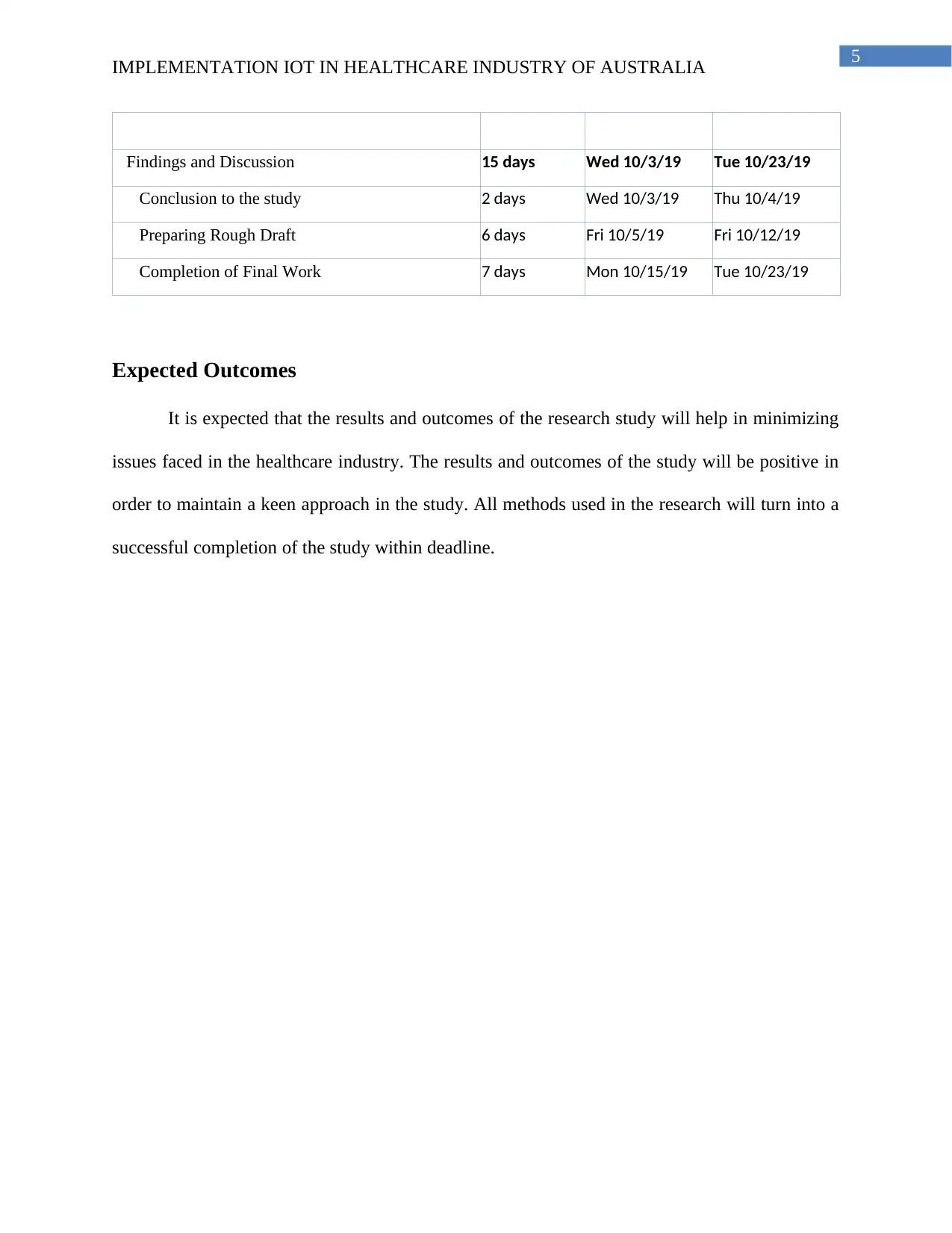
5
IMPLEMENTATION IOT IN HEALTHCARE INDUSTRY OF AUSTRALIA
Findings and Discussion 15 days Wed 10/3/19 Tue 10/23/19
Conclusion to the study 2 days Wed 10/3/19 Thu 10/4/19
Preparing Rough Draft 6 days Fri 10/5/19 Fri 10/12/19
Completion of Final Work 7 days Mon 10/15/19 Tue 10/23/19
Expected Outcomes
It is expected that the results and outcomes of the research study will help in minimizing
issues faced in the healthcare industry. The results and outcomes of the study will be positive in
order to maintain a keen approach in the study. All methods used in the research will turn into a
successful completion of the study within deadline.
IMPLEMENTATION IOT IN HEALTHCARE INDUSTRY OF AUSTRALIA
Findings and Discussion 15 days Wed 10/3/19 Tue 10/23/19
Conclusion to the study 2 days Wed 10/3/19 Thu 10/4/19
Preparing Rough Draft 6 days Fri 10/5/19 Fri 10/12/19
Completion of Final Work 7 days Mon 10/15/19 Tue 10/23/19
Expected Outcomes
It is expected that the results and outcomes of the research study will help in minimizing
issues faced in the healthcare industry. The results and outcomes of the study will be positive in
order to maintain a keen approach in the study. All methods used in the research will turn into a
successful completion of the study within deadline.
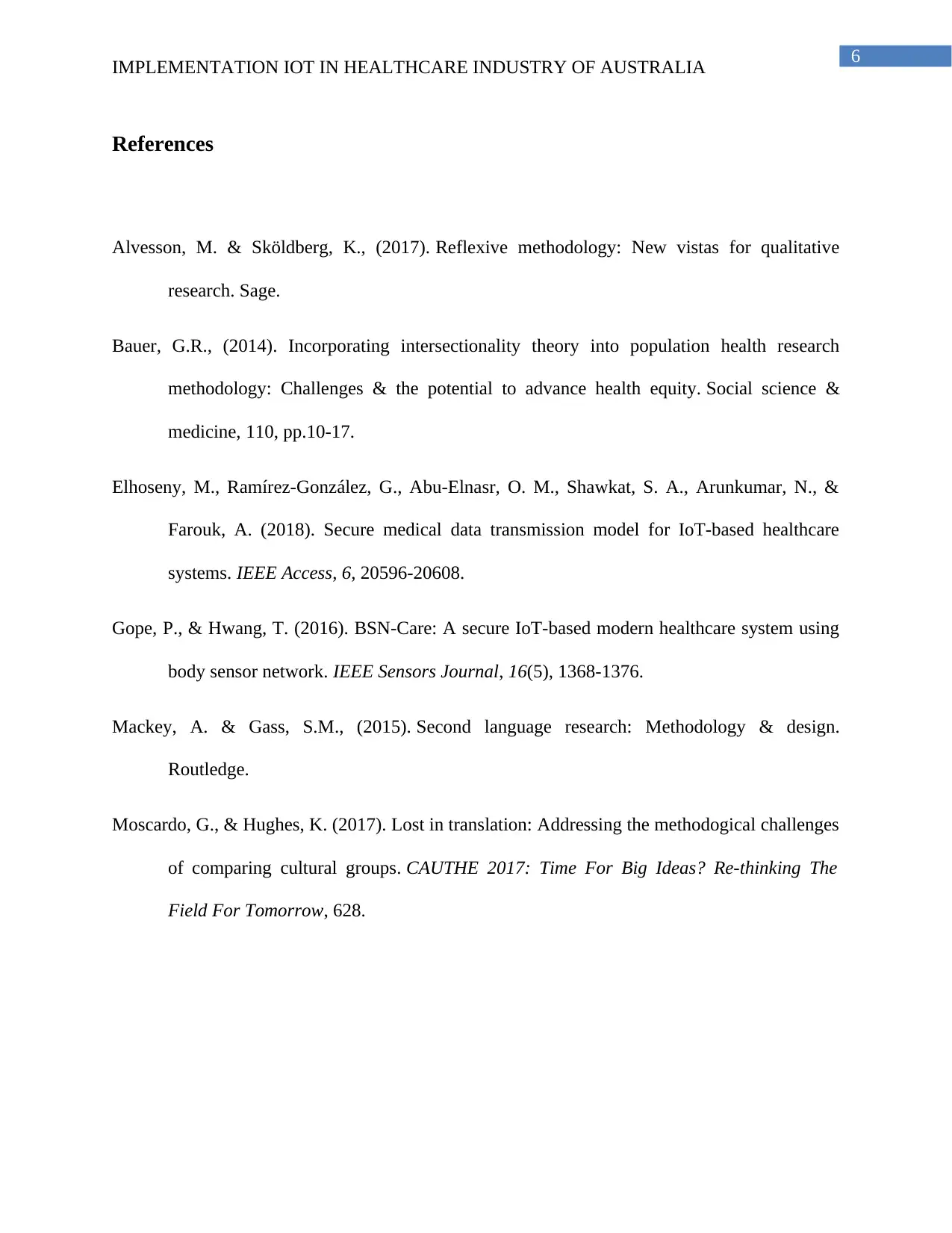
6
IMPLEMENTATION IOT IN HEALTHCARE INDUSTRY OF AUSTRALIA
References
Alvesson, M. & Sköldberg, K., (2017). Reflexive methodology: New vistas for qualitative
research. Sage.
Bauer, G.R., (2014). Incorporating intersectionality theory into population health research
methodology: Challenges & the potential to advance health equity. Social science &
medicine, 110, pp.10-17.
Elhoseny, M., Ramírez-González, G., Abu-Elnasr, O. M., Shawkat, S. A., Arunkumar, N., &
Farouk, A. (2018). Secure medical data transmission model for IoT-based healthcare
systems. IEEE Access, 6, 20596-20608.
Gope, P., & Hwang, T. (2016). BSN-Care: A secure IoT-based modern healthcare system using
body sensor network. IEEE Sensors Journal, 16(5), 1368-1376.
Mackey, A. & Gass, S.M., (2015). Second language research: Methodology & design.
Routledge.
Moscardo, G., & Hughes, K. (2017). Lost in translation: Addressing the methodogical challenges
of comparing cultural groups. CAUTHE 2017: Time For Big Ideas? Re-thinking The
Field For Tomorrow, 628.
IMPLEMENTATION IOT IN HEALTHCARE INDUSTRY OF AUSTRALIA
References
Alvesson, M. & Sköldberg, K., (2017). Reflexive methodology: New vistas for qualitative
research. Sage.
Bauer, G.R., (2014). Incorporating intersectionality theory into population health research
methodology: Challenges & the potential to advance health equity. Social science &
medicine, 110, pp.10-17.
Elhoseny, M., Ramírez-González, G., Abu-Elnasr, O. M., Shawkat, S. A., Arunkumar, N., &
Farouk, A. (2018). Secure medical data transmission model for IoT-based healthcare
systems. IEEE Access, 6, 20596-20608.
Gope, P., & Hwang, T. (2016). BSN-Care: A secure IoT-based modern healthcare system using
body sensor network. IEEE Sensors Journal, 16(5), 1368-1376.
Mackey, A. & Gass, S.M., (2015). Second language research: Methodology & design.
Routledge.
Moscardo, G., & Hughes, K. (2017). Lost in translation: Addressing the methodogical challenges
of comparing cultural groups. CAUTHE 2017: Time For Big Ideas? Re-thinking The
Field For Tomorrow, 628.
⊘ This is a preview!⊘
Do you want full access?
Subscribe today to unlock all pages.

Trusted by 1+ million students worldwide
1 out of 6
Related Documents
Your All-in-One AI-Powered Toolkit for Academic Success.
+13062052269
info@desklib.com
Available 24*7 on WhatsApp / Email
![[object Object]](/_next/static/media/star-bottom.7253800d.svg)
Unlock your academic potential
Copyright © 2020–2025 A2Z Services. All Rights Reserved. Developed and managed by ZUCOL.





